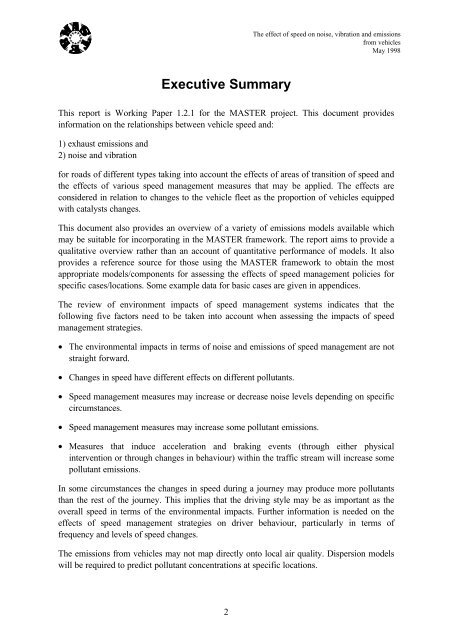appendix a - Velocidade
appendix a - Velocidade
appendix a - Velocidade
You also want an ePaper? Increase the reach of your titles
YUMPU automatically turns print PDFs into web optimized ePapers that Google loves.
Executive Summary<br />
2<br />
The effect of speed on noise, vibration and emissions<br />
from vehicles<br />
May 1998<br />
This report is Working Paper 1.2.1 for the MASTER project. This document provides<br />
information on the relationships between vehicle speed and:<br />
1) exhaust emissions and<br />
2) noise and vibration<br />
for roads of different types taking into account the effects of areas of transition of speed and<br />
the effects of various speed management measures that may be applied. The effects are<br />
considered in relation to changes to the vehicle fleet as the proportion of vehicles equipped<br />
with catalysts changes.<br />
This document also provides an overview of a variety of emissions models available which<br />
may be suitable for incorporating in the MASTER framework. The report aims to provide a<br />
qualitative overview rather than an account of quantitative performance of models. It also<br />
provides a reference source for those using the MASTER framework to obtain the most<br />
appropriate models/components for assessing the effects of speed management policies for<br />
specific cases/locations. Some example data for basic cases are given in appendices.<br />
The review of environment impacts of speed management systems indicates that the<br />
following five factors need to be taken into account when assessing the impacts of speed<br />
management strategies.<br />
• The environmental impacts in terms of noise and emissions of speed management are not<br />
straight forward.<br />
• Changes in speed have different effects on different pollutants.<br />
• Speed management measures may increase or decrease noise levels depending on specific<br />
circumstances.<br />
• Speed management measures may increase some pollutant emissions.<br />
• Measures that induce acceleration and braking events (through either physical<br />
intervention or through changes in behaviour) within the traffic stream will increase some<br />
pollutant emissions.<br />
In some circumstances the changes in speed during a journey may produce more pollutants<br />
than the rest of the journey. This implies that the driving style may be as important as the<br />
overall speed in terms of the environmental impacts. Further information is needed on the<br />
effects of speed management strategies on driver behaviour, particularly in terms of<br />
frequency and levels of speed changes.<br />
The emissions from vehicles may not map directly onto local air quality. Dispersion models<br />
will be required to predict pollutant concentrations at specific locations.


